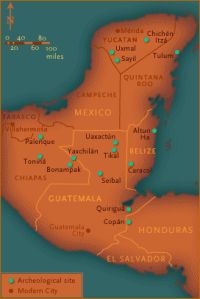If you take a look at

Map of Mayan Civilization
|
the Kebroak bag and their website, you will see that this charcoal is advertised as "Mayan Hardwood Lump Charcoal." So we've all heard of the Mayans, but then we've heard of the Aztecs, too. Where exactly was the Mayan civilization located? From Wikipedia we learn that the Mayan civilization
"...extended throughout the southern Mexican states of Chiapas, Tabasco, and the Yucatán Peninsula states of Quintana Roo, Campeche and Yucatán. The Maya area also extended throughout the northern Central American region, including the present-day nations of Guatemala, Belize, El Salvador and western Honduras."
We provide the map at right to help you get your bearings. You see, this charcoal is manufactured in Guatemala, Honduras and El Salvador, hence the Mayan connection.
Next, you may be wondering about the name "Kebroak." Actually, it is a made up name. The "oak" part comes from the fact that the wood used to make the charcoal is from the oak family. The "Kebr" part of the name is reminiscent of the Argentinian "Quebracho" (which means axe-breaker because of the denseness of the wood). "Kebr" plus "oak" makes "Kebroak."
Since this charcoal is very new, we thought we'd add that you can buy this charcoal in South Florida and online. You can also get pallets by calling or ordering online. The price varies from retailer to retailer, but the price for a 20-pound bag runs between $10 and $14. It also comes in 10 and 5-pound bags.
Now that we have all of that out of the way, let's take a look at the charcoal. As usual, the first thing we do is dump the charcoal out on the ground for sorting and examination. We found about 2 ounces of uncarbonized wood, four small stones and a bit of what resembles wheat straw and dead leaves scattered amongst the charcoal. There was also a small strip of plastic. You can see what we found in the photo below. We weren't really concerned with what we found as the amounts were so small.
As for size distribution, at first glance it looks pretty good, but as we dug into the charcoal we discovered there were no pieces in the bag that we could really justify calling large. So, the entire bag was comprised of medium and small pieces, as well as the chips and dust in the bottom of the bag:
| Large |
0.0 pounds |
0.0% |
| Medium |
10.1 pounds |
50.1% |
| Small |
7.4 pounds |
36.3% |
| Chips/Dust |
2.8 pounds |
13.6% |
|
|
|
| Total |
20.3 pounds |
|
|
The chips and dust were on the high side of being average when compared to all lump charcoals that we have reviewed. Overall, the distribution was good, but we'd like to see some large pieces in the bag and less chips and dust in the bottom.
Next we have the lighting test in which we see how many sheets of newspaper it takes to get a fire established in a chimney starter. Kebroak took 4 sheets which is average compared to other lump charcoals. While it burned there was almost no sparking and definitely no popping. The smoke is a moderate and pleasant wood smoke.
The next test is the maximum temperature test. We got this charcoal up to 936 degrees which is high compared to other charcoals. Again while burning full tilt in a ceramic cooker there was almost no sparking and no popping. When lighting the charcoal with a MAPP torch, however, we got a violent pop which ejected a shard of charcoal some distance. We would caution you to be very careful in using a MAPP torch with this charcoal.
In our burntime test, Kebroak only burned an average length of time compared to other charcoals and it also produced an average amount of ash compared to other charcoals.
So what we have is a charcoal that rated "average" in four out of five key indicators. The price makes it a bit more attractive than that, so with several average results and one better than average result, we give our Above Average rating to this charcoal.

